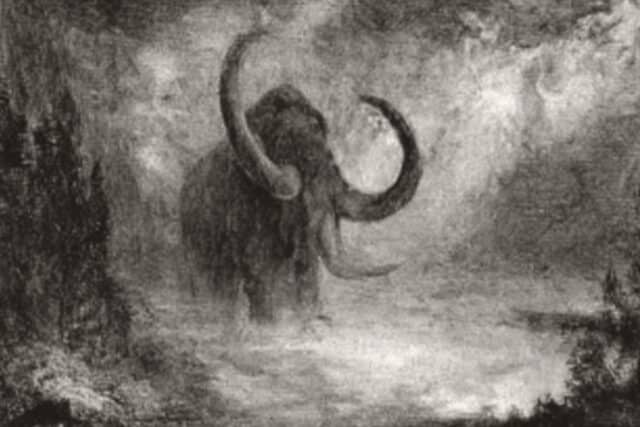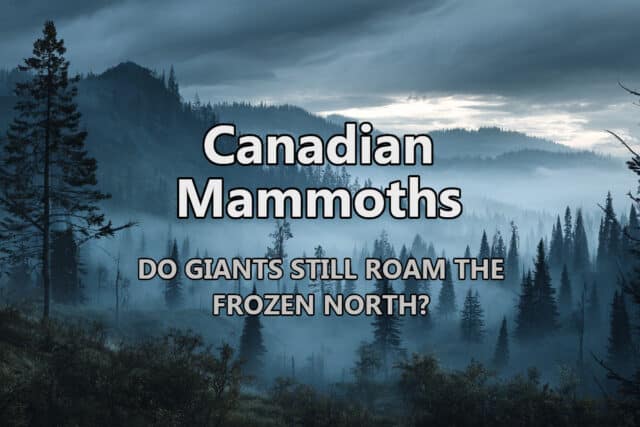
In 1899, a fantastic tale emerged from the Alaskan wilderness: Henry Tukeman claimed to have tracked down and killed the very last living woolly mammoth.
The story, published in the prestigious McClure’s Magazine, captivated readers across America. Tukeman wrote of befriending an Indigenous hunter named Joe at Fort Yukon in 1890, who became excited when shown a picture of an elephant. “He said he had seen such an animal, up there,” pointing north and east toward the Porcupine River.
Joe described encountering a massive creature bathing in a lake, with “two front teeth stand out before his head for ten gunlengths, turned up and shining like a swan’s wing in the sunlight.” The beast was so enormous that “alongside him, this cabin would be like a two-week boar cub beside its mother.”
Tukeman’s account detailed an elaborate hunt involving fire traps and tree platforms, ultimately bringing down what he claimed was the last mammoth. The specimen allegedly went to the Smithsonian Institution, donated anonymously by a wealthy benefactor.
The story was pure fiction—a creative writing exercise that McClure’s editors assumed readers would recognize as fantasy. But the “mammoth mania” it sparked deluged both the magazine and the Smithsonian with letters from visitors demanding to see the creature. As one official later wrote, the institution was “beset with visitors to see the stuffed mammoth” that never existed.
The Modern Mammoth Mirage
More than a century later, the dream of surviving mammoths refuses to die. In 2012, a grainy video purporting to show a live woolly mammoth crossing a river in Siberia went viral, making headlines worldwide and sparking intense debate across social media.
The footage was allegedly captured by a government engineer surveying a road project in the remote Chukotka Autonomous Okrug region. The dark, blurry creature moving through the water looked tantalizingly mammoth-like, complete with what appeared to be a distinctive trunk and massive bulk.
But the truth soon emerged. Australian filmmaker Lou Petho revealed that the “mammoth” footage was doctored from his own video of the Kitoy River, shot while documenting his grandfather’s escape from a Siberian prison camp. “I don’t recall seeing a mammoth; there were bears, deer, and sable,” Petho told investigators. “But no woolly mammoths. I had no idea my footage was used to make this fake sighting.”
The hoax followed a familiar pattern: take genuine wilderness footage, add digital manipulation, and present it as evidence of surviving megafauna. Yet beneath these modern deceptions lies a more intriguing question—while mammoths may truly be gone, could other “extinct” giants still roam our planet’s most remote corners?
The Science of Survival
Recent scientific discoveries suggest that “extinction” is far more complex than a simple end date. Woolly mammoths survived on Wrangel Island in the Arctic Ocean until around 4,000 years ago—well into the era of human civilization and several centuries after the construction of the Great Pyramid of Egypt.
On St. Paul Island in Alaska, another mammoth population persisted until roughly 5,600 years ago, meaning these ice age giants were still thundering across the tundra when ancient Bronze Age civilizations flourished in Mesopotamia.
Even more recently, environmental DNA studies suggest mammoths may have survived in mainland Alaska until about 5,700 years ago—thousands of years longer than previously thought. If mammoths could persist in isolated refugia for millennia beyond their supposed extinction, what other “lost” species might still endure in Earth’s most inaccessible wilderness?
Indigenous Memories of Giants

Native American oral traditions offer tantalizing hints that some peoples retained cultural memories of these vanished giants. The Kaska tribe of northern British Columbia preserved accounts of “a very large kind of animal which roamed the country a long time ago. It corresponded somewhat to white men’s pictures of elephants. It was of huge size, in build like an elephant, had tusks, and was hairy.”
The narrator told ethnologists that “these animals were seen not so very long ago, it is said, generally singly, but none have been seen now for several generations.” He described finding a shoulder blade “as wide as a table (about three feet)” during recent travels.
Multiple Algonquian legends describe encounters with enormous, elephant-like creatures that possessed trunks capable of grasping like human arms—a detail that suggests more than fossil discoveries, since “no savage who had never heard of the use of an elephant’s trunk would imagine from a sight of the dead animal, even if its trunk were perfect, that its use was to be compared with that of a man’s arm.”
Similarly, researchers have suggested that Indigenous thunderbird stories may be based on discoveries of pterosaur fossils by Native Americans, creating a cultural bridge between ancient encounters and modern sightings of giant flying creatures.
Echoes of Forgotten Eras
The tantalizing possibility of surviving “extinct” giants extends far beyond mammoths and isolated islands. Across the globe, people report encounters with creatures that seem ripped from prehistoric textbooks—living dinosaurs, giant sloths, and winged reptiles that should have vanished millions of years ago.
In the American Southwest, witnesses describe massive flying creatures with leathery wings and reptilian features. In 1890, two Arizona cowboys claimed to have shot and killed a large bird with no feathers and “a head similar to that of an alligator.” More recently, Texas police officers reported seeing what became known as the “Texas Big Bird”—a creature that matched descriptions of pterosaurs rather than any known bird species.
These modern “thunderbird” sightings echo Indigenous traditions spanning centuries. Native American legends consistently describe enormous flying creatures whose wingbeats created thunder and whose eyes flashed lightning. Could these be cultural memories of encounters with surviving pterosaurs? The prehistoric flying reptile Quetzalcoatlus, with its 40-foot wingspan, once soared over Texas—its fossils discovered there as recently as 1972.
Deep in the Amazon rainforest, indigenous communities speak of the Mapinguari, a creature that sounds remarkably like descriptions of giant ground sloths that supposedly died out over 11,000 years ago. Witnesses describe a massive, foul-smelling beast standing over seven feet tall, with powerful claws and matted reddish fur. “The clincher that really blew me away,” said anthropologist Glenn Shepard, came when a Machiguenga tribesman mentioned he had seen a mapinguari—at the natural history museum in Lima, where a diorama displayed a model giant ground sloth.
Even more intriguing are the reports from the Congo Basin, where local peoples have long told stories of Mokele-mbembe, “one who stops the flow of rivers.” Described as elephant-sized with a long neck and small head, these accounts bear striking resemblance to sauropod dinosaurs. Fisher Emmanuel Mambou recalls casting his net when “a large ripple disturbed the water” and something massive emerged that didn’t match any known animal in the region.
When “Extinct” Means “Unconfirmed”
The most compelling modern case for surviving “extinct” megafauna comes from Tasmania, where the Tasmanian tiger or thylacine officially died out in 1936. Yet recent scientific analysis of 1,237 reported sightings suggests these wolf-like marsupials may have survived until the late 1980s or 1990s, with a small possibility they could still exist today.
Neil Waters of the Thylacine Awareness Group firmly believes in their continued existence: “Do I think the animal is extinct? No, because I have seen two and been coughed/barked at by one in South Australia in 2018. There have been more than 7,000 documented sightings of thylacines.”
The pattern extends globally. Javan tigers, officially extinct since 1976, were allegedly rediscovered by a forester in 1995, with continued sightings throughout the 2000s. Baiji dolphins, declared extinct in 2006, had a confirmed sighting just one year later by a team of scientists.
Tasmanian Tiger Spotted in Wyoming?
The Challenge of Proving Absence
Science faces a fundamental challenge: proving something doesn’t exist is nearly impossible, especially in remote wilderness areas. A species can remain undetected for decades if its population is small and its habitat inaccessible. The cryptid community understands this paradox—absence of evidence is not evidence of absence.
This challenge becomes more complex when we consider the sheer vastness of unexplored territory. The Congo Basin spans 1.1 million square miles of largely impenetrable rainforest. The Amazon contains millions of acres where no scientist has ever set foot. Remote valleys in Papua New Guinea and the Siberian wilderness remain as mysterious today as they were centuries ago.
The pattern of sightings often follows deforestation and human encroachment. As National Geographic reports, Congolese biologist Joseph Oyange watched a family clear two hectares of jungle, displacing gorillas who then foraged in fields by night. When the family heard gorilla cries, a teenager told Oyange “It was mokele-mbembe roaring.” Similar misidentifications may explain some sightings, but they also reveal how rarely people encounter large, unknown animals in undisturbed habitats.
Modern technology has made some remote areas more accessible, but vast swaths of wilderness remain largely unexplored. The boreal forests where mammoths once roamed span millions of square miles, much of it accessible only by helicopter or on foot. If isolated populations of “extinct” species have survived in these refugia, they might encounter humans only when their habitats shrink or when people venture deeper into previously untouched regions.
Climate change is also revealing new evidence of past survivors. Melting permafrost regularly exposes mammoth remains across Siberia and Alaska, some so well-preserved they retain soft tissue, hair, and even DNA. If frozen specimens can survive for millennia, could living populations have persisted in isolated refugia longer than we thought?
The Believer’s Balance
While hoaxes like the 2012 mammoth video damage the credibility of legitimate research, they also reveal our deep-seated hope that Earth still harbors hidden wonders. The line between healthy skepticism and close-minded dismissal is often thin.
As researchers note, “determining the reliability and credibility of a sighting is highly subjective.” A fleeting glimpse through forest shadows or across a valley could be anything—or could be everything.
The key lies in approaching such possibilities with both open minds and rigorous standards. While we shouldn’t believe every blurry photograph or breathless account, we also shouldn’t dismiss the possibility that our planet’s most remote corners might still harbor surprises from another age.
Recent discoveries consistently remind us how much we don’t know. New species are discovered regularly, sometimes in areas that scientists thought were thoroughly explored. If we’re still finding new animals, isn’t it possible that some “extinct” ones never truly disappeared?
The Giants Among Us
Whether woolly mammoths still trumpet in Siberian valleys, Tasmanian tigers still hunt in Australian wilderness, pterosaurs still soar over Texas skies, or giant sloths still lumber through Amazon forests, these stories reflect something deeper than wishful thinking. They represent our recognition that extinction may not always be forever, and that our planet’s wild places may yet harbor mysteries we’ve only begun to imagine.
The truth behind Henry Tukeman’s 1899 tale wasn’t a living mammoth—but it was something equally fascinating: evidence of how Indigenous peoples preserved genuine memories of vanished giants across thousands of years. Those memories, combined with modern scientific discoveries of extended survival dates and ongoing sightings of supposedly extinct creatures worldwide, suggest that the boundary between “extinct” and “hidden” may be more porous than we assumed.
From the thunderbirds of Native American legend to the mapinguari of the Amazon, from the mokele-mbembe of the Congo to the continuing thylacine sightings of Tasmania, a pattern emerges of creatures that refuse to stay extinct in human consciousness. Some may be misidentifications, others may be folklore—but the persistence and consistency of these accounts across cultures and continents suggests that our understanding of extinction itself may need revision.
In our mapped and monitored world, the possibility that giants still walk among us offers a tantalizing reminder that Earth’s story is far from finished, and some chapters we thought were closed might still have pages left to write. Whether soaring through desert skies, padding through rainforest shadows, or swimming in remote rivers, the giants of yesterday may yet prove to be the discoveries of tomorrow.
Have you experienced a sighting of an animal thought to be extinct? We’d love to hear your story. Send your report to Reports@ParaRational.com











